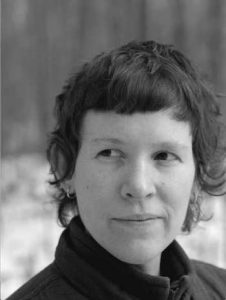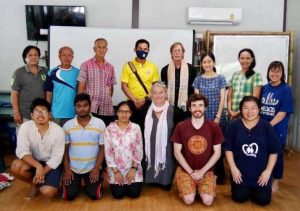To be a senior rinpoche or lama is a rare privilege. To be born into a family of ancient and illustrious lineage holders, such as the House of Khön, is an even rarer simultaneous blessing and burden. The Khön clan founded the Sakya school in the 11th and 12th centuries and has led it ever since. But perhaps most unusual and most interesting of all is to marry into such a family, to serve the Dharma from within the Khön clan at its very heart, as mother and wife, leader and nurturer. Dagmo Kalden Dunkyi Sakya holds not only this respected role, but also many others as a giver of service, which she discusses among other subjects in this extended conversation.
Dagmo Kalden Dunkyi Sakya is beloved among her Vajrayana community for her charisma, friendliness, and humor. Since since 12 September 2002, she has been married to Ratna Vajra Rinpoche, the 42nd Sakya Trizin from 2017–22. I remember interviewing her husband in 2016, and despite the passage of time, His Eminence was and remains the steadfast and tireless face of the Sakya teachings, second only to his father, the 41st Sakya Trizin, His Holiness Kyabgon Gongma Trichen Rinpoche.
As a senior female member of the family, Dagmo-la is also prominent in a different way: she is involved in many projects and sees herself as a giver of time, care, and service. She is one of the few senior members of a lineage-holding family to be an active user of social media, and indeed an influencer. Born in 1978 in Kalimpong, India, there was initially little indication of the religious life she would lead. “My life before 2002 was spent in a boarding school and then in college. All of my formative years were therefore immersed in a fairly academic environment. I worked hard both in the classroom and outside of it,” she tells me. Coincidentally, 2002 was the year I began my own time at boarding, while Dagmo-la was just finishing up.
“I really did not know life as anything else. A teacher once called me ‘Golden Girl,’ mainly because I was a good student and also because of all the sports I took part in. I was the captain of the girls’ swim team, and it seems like such a world away from where I am now,” Dagmo-la reminisces. She was busy, even during her holidays. “I used to volunteer at local NGOs when back home, so I think my interest in volunteerism and service was always there. After coming into the Sakya family, I am indeed very grateful that I have so many opportunities to serve others on a much larger scale than if I was by myself.”
Since marrying and building a family after 2002, Dagmo-la’s interest in social work has only grown, especially after she has seen the immense connections and opportunities she wields. At her fingertips are many means for helping people while involving members of the community themselves. “Being in this position, I also am very careful to not misuse my opportunities and resources for my personal gain. My social work with and for the community has given me incredible strength and satisfaction, and I now find myself automatically thinking of what needs to be done in the community and whether I can fulfill that need somehow,” she emphasizes.
Sakya Hospital: to heal and to help
The seat of the Khön clan is in the family monastery in Dehra Dun, and the Sakya Hospital, founded in 2002, is an institution dear to Dagmo-la’s heart. Her bond with the hospital technically began before she was married, through her mother’s first meeting with her future mother-in-law. Their exchange seems to have been a harmonious blend of traditional obligations and genuine friendship. Dagmo-la’s marriage was an arranged one: “The parents met each other before the bride and groom did!” Dagmo-la recalls mirthfully. But it was understood between the senior women that given Dagmo’s comprehensive education and flourishing activities, it would be good to nurture her personal interests. “My mother-in-law told my mother about the Sakya Hospital after she heard about my interest in social work during my college years.”
Giving time productively has always come naturally to Dagmo-la since her time as a college student, when she and her peers worked on campus. When she formally joined the Khöns, His Holiness the 41st Sakya Trichen asked her to take over the secretarial duties of the family. She recalls feeling delighted about being able to be “useful,” but also to work in a familiar environment. “I spent my days writing and replying to His Holiness’s numerous mail, creating mailing lists, and sending cards, letters, and emails all over the world. In my free time, I also recall cataloguing all the books in the family library!”
Aside from assisting her father-in-law, Dagmo-la felt an affinity with those that needed healthcare. “Sakya Hospital was initially started with the support of generous donors and Dharma friends in Europe, mainly disciples of Ven. Sherab Gyaltsen Amipa,” she says. “It was blessed by His Holiness the 41st Sakya Trizen, and the foundation stone was laid by the 42nd Sakya Trizin. I believe it was started with the main aim of providing medical care to our Sakya monks and nuns.” A few years after her marriage, Dagmo-la decided that the time was right for her to invest more time and effort into Sakya Hospital. First, she started off cataloguing hospital inventory on her own.
“I began writing to donors, and at the same time began working on making sure the hospital adhered to the country’s health standards and requirements. It was a very fulfilling time for me as I more or less single-handedly looked after the hospital,” she recalls with pride. It was after she was expecting her first child that she decided to find someone who could commit full-time to the institution. While she is still Sakya Hospital’s director, she no longer oversees its daily operations.
“I slowly began to reach out to the local community in order to let it be known that our services were for the entire community and not just monks and nuns. It gives me much happiness to say that over the years we have not only provided healthcare to our monks and nuns, but to the entire local community. I have met many Indians in the community who speak highly of the hospital, and it warms my heart,” says Dagmo-la.
“Among other institutions, we have close and special relationships with the blind and differently abled schools in the area, and have special rates for them. We have slowly added to the medical services we provide with the help and assistance of generous sponsors for example, ophthalmological, and hospice services. We very often treat low-income patients completely for free if they are unable to pay the low cost of our medical services. We have performed many free health camps, awareness talks, fogging against dengue and malaria, and even performed free surgeries.”
Currently the hospital is closed for renovation, but Dagmo-la and her colleagues plan to open its doors to the community soon so that the team can get back to serving the community with compassion.
Motherhood and marriage: embodying love
Dagmo-la is comfortable in many identities of giving. One of the most intimate and important of these, of course, is that of a loving mother. “Being a mother has taught me many things, but the most important thing it has taught me is to not sweat the small stuff, and to be more relaxed when it comes to rules and goals that you as a parent have for your children. Many of us parents have so many hopes and aspirations for our children, and that is good, but when those hopes and aspirations cause stress and unhappiness, is it really worth it? I think it’s very important to balance a lot of these out and be willing to shift and change—for the benefit of everyone.”
Despite their mutual devotion and her happiness at being a complement to her husband, the marriage is admittedly not the usual kind due to Ratna Vajra Rinpoche’s unique identity. This means that Dagmo-la has had many years and opportunities to observe up close and personal what being a Buddhist leader means. “Being a wife of His Holiness has taught me the importance of acceptance, understanding, and compromise. Relationships are never about just one person, and should not be seen as some sort of barter system of power, profit, and loss,” she says. “My marriage is not an ordinary one so I do not want to say too much here. Rinpoche sometimes travels for more than half the year, and when he is at home he is sometimes so busy, I rarely see him then too. But I understand that he has an important role to fulfill, and that he has dedicated his life to the Dharma.”
Dagmo-la’s thoughts are deep and honest as she contemplates her relationship, which she has received much from and given much to: “From the moment I first knew him, I have found that his priorities and what he considers important and vital are not himself, but the greater good, the larger picture, and the longer run. In that aspect we are both very similar: I can honestly say that almost everything we do is guided and motivated by its benefit and impact on others. I think we have both been like this since childhood.
“Because we both believe firmly in this, it many times leads us to working quite hard for causes and reasons that would be beneficial to the larger community. That has in turn led me to accepting many aspects of this unique marriage and relationship that others might not accept so willingly.”
It would be fair to acknowledge that there is both great respect and considerable sacrifice accorded to a marriage of this gravity. Dagmo-la’s children must also inevitably carry themselves into roles that uphold the sacred dignity of the Sakya school.
On leadership: honesty and preserving ritual and culture
Dagmo-la is the first to concede that everyone has an opinion on what makes a good leader. “There are many different qualities, hence we are fortunate that there are such a wide variety of teachers for this very wide variety of students! I personally have quite strict requirements. For me, one of the main qualities I would wish for a teacher to have is of course the knowledge, but also the honesty. In our situation, when people place so much faith in the teachers and leaders, it is especially important for the teachers to be true to their word, their practice, and their own teachings.”
She elaborates: “In this day and age, when it’s easy to give an impression of being a certain way through a photograph or a social media post, I think it’s even more worrisome because one can give an impression of being something one is actually not, and hence be deceptive. Therefore, for me, honesty is key. It is a huge responsibility for a Buddhist leader to practice what they preach, but as leaders and guardians of the faith, I believe it is the only way. For this reason, I have the highest regard for those few gurus whom I have seen close-up over many years, and who have been the same whether there are people around them or not, whether there is a camera present or not, and whether they are in public or in private.”
Dagmo-la also believes that another essential quality of a Buddhist leader is a strong sense of purpose and responsibility to preserve and share the words and teachings of the Buddha, as well as preserve Buddhist practices: “Without a sense of purpose and maybe even a sense of urgency, that need, and that drive to work tirelessly and single-pointedly for the Dharma would not be strong enough.”
Tradition and modernity
I ask Dagmo-la about how, in the context of Vajrayana rituals, tradition and respect for continuity can be balanced with openness toward new ways of doing things and changing mindsets. She is happy to answer but remains modest about the extent of her knowledge: “I am familiar with, but not well-versed in Vajrayana rituals. And while I have traveled and met many people from many backgrounds and regions, I am nowhere as well-traversed as our lamas, especially since I had my children and decided to dedicate most of my time to them. You have asked an excellent question and one that I am not sure I would be able to answer well at all. Having said that, I will share my humble opinion.”
Dagmo-la begins by reflecting: “With our newer generations growing up all across the world, in increasingly secular environments, it is a very relevant question you have asked and one that must be discussed and seriously pondered upon. I think that the balance you mention can best come about through wisdom, open-mindedness and flexibility. A lack of judgement about things one is not familiar with, but also being wise in selecting what really would benefit from change and what ought to be kept traditional and unchanged.”
She believes that communities need to accept the prospect that younger generations might not accept many aspects of Tibetan Buddhist practice. New generations are growing up in non-traditional environments, which inevitably foster fresh and independent ways of thinking. “The sooner we accept that some change is inevitable, less energy can be expended struggling to hold onto that which cannot be held onto, and instead diverted to newer ways of helping the younger generation understand and connect with other aspects of our ancient Buddhist wisdom and practices,” she emphasizes—in this respect, and many others, her wisdom is truly estimable.
“Likewise for the younger generation, there will be many things that might not immediately make sense, and that is okay too. Buddhism is so deep and nuanced that to judge and reject immediately based on one concept that doesn’t stick is also extreme. I think that, in general, the big thing to keep in mind is to be openminded and flexible, yet to be wise and not change everything. Our wisdom is ancient, but the methods to understand that wisdom can be changed or altered or adapted so that they make sense and can be accepted by people of different times, backgrounds, and experiences.”
Making connections: rallying support on social media
Dagmo-la is famous for her online life and for building a social media following. Yet how she leverages this large following to spread awareness of her activities is extraordinary. “I try to use social media as a means to connect with people and to raise awareness, being a conduit between the rinpoches and the rest of the world, to give thanks and shout-outs, support individuals and organizations, and generally nurture a sense of community.” She is the only senior Sakya family member to be a frequent social media user.
“It is a wonderful tool to not only connect with people, but also assist them and spread awareness about many issues,” Dagmo-la says. Like many others, she began on a much smaller scale, sharing photos of her children with their family and the Sakya sangha, especially as her daughter was the first child to be born after some time. Upon her close friend’s advice, it slowly became a way for her to share informal family moments, information beneficial to the community, and practical assistance to the community.
“Since then, I have never looked back! I would sometimes share informal, unscripted moments on my personal page, especially of my children and Their Holinesses the 41st and 42nd Sakya Trizins, with whom I live in the same household. These moments, not surprisingly, gave many people a sense of connection with them, seeing them in a different light and environment, and not on a formal throne or at a puja. Many of my friends who are non-Sakya (and also not very religious) have mentioned to me the respect they began to feel for our rinpoches after seeing these sweet, candid moments!”
Dagmo-la credits via social media for being able to personally speak with more people in her community, who would write with various personal questions and requests for assistance. “From asking for divination requests from His Holiness, to asking me which direction their shrine should face; from requesting the name of a newborn baby, to sharing their life issues and thoughts with me, social media has truly helped me to help many people in my limited capacity.”
Social media has revealed how many people connect with her at a deep and personal level: “So many wrote to actually thank me for giving them the opportunity to help others. I was slowly beginning to understand the power of social media and using it correctly for the benefit of others. I’m very grateful to all the friends and acquaintances I’ve made on social media, who have been so supportive of the projects I’ve shared with them and the assistance I have many times sought.”
Social media has also helped her to raise hundreds of thousands of rupees in funds for sick children, animal shelters, victims of fire, and medical workers during the pandemic over rapid and short bursts of time. “I began to share the Mahavairocana Puja days with the public as well, so that people from all over could send in the names of their loved ones who had passed on. This has never been done before, and I took it upon myself personally to collect and submit all the names I was sent. I received tens of thousands, every single time I did a name drive. I saw it as a wonderful opportunity for me to provide service and also peace of mind to all the family members. A wonderful thing!
“During COVID I also requested His Holiness to bestow a kah-go for the benefit of all because it was such a distressing and uncertain time, and I went live with the video, for which hundreds of thousands of people tuned in and felt comforted and strengthened. Such is the power of social media. Truly amazing!”
It is to COVID-19 that our conversation now turns, and we come full circle back to Sakya Hospital.
Post-pandemic: coming full circle back to healing
Social media played a large part in helping Dagmo-la navigate the greatest challenge to face her community in recent years: the COVID-19 pandemic. “Thank you for asking me about this,” she says, “because it was such a stressful time for everyone, and a time that now seems so long ago, I had almost forgotten until your question made me remember all that I did.”
In 2020, Dagmo-la had never been busier. She believes that social workers play a crucial role during such periods of crisis. “For me, my commitment to society in general and my personal goal to be of as much benefit to the community as I can fueled me to action. One of the first things I did was to have vital information about the coronavirus issued by the WHO translated into Tibetan. We printed and put up posters in the entire Tibetan community around Dehra Dun, while also sharing the digital files online for those who wanted it to share it with ease. Then I held awareness talks by one of our Dharma friends who is also a nurse in our monasteries. Since hand-washing was encouraged, I purchased and installed hundreds of hand-soap dispensers at all washbasin stations in the monasteries and settlements.”
As the pandemic worsened, and mask-wearing was encouraged, there was a shortage of masks, so Dagmo-la decided to employ women who had been made jobless. She assigned them the task of sewing masks. “During this time, I would go into town almost daily to purchase cloth, make and print the designs, and visit the seamstresses. I felt that I could not task someone else to do it because I was afraid for my own health—so I went myself.” Even with adequate personal preparation, this was an extraordinary thing for a lineage holder’s partner to do. “On the other days, I would drive into town to hand out masks to anyone not wearing one. I also visited all the local old people’s homes personally and gave them masks and holy nectar pills, since the elderly were an especially vulnerable population.”
To encourage more people to wear masks, Dagmo-la became creative. She came up with numerous designs that would appeal to young and old alike. “In order to reduce single-use masks, I used cotton and other natural materials. My masks were not the best or most comfortable, but we sewed thousands and shipped many across the world. Many generous people even sent us money to sew masks that we could distribute. In general, with the profits earned, we were able to support many women’s livelihoods, and also sew lots of masks that we distributed for free. We also shipped them, in bulk and for free, to anyone and any institution who asked, as well as offering them to migrants leaving India and going back to their homes once the lockdown began.”
When she was made aware of the plight of healthcare workers in southern India, Dagmo-la again harnessed the power of social media, raising hundreds of thousands of rupees in contributions from people all over the world and distributing the money to the healthcare workers. “As I mentioned earlier, at the beginning of the pandemic, I also requested His Holiness to bestow the kah-go live on Facebook because everyone was worried and scared, and I knew that this would bring comfort and peace of mind to many. His Holiness, as always, so kindly and generously acquiesced to my humble request—I believe tens of thousands of people tuned in to receive the blessings.”
Dagmo-la further describes: “When our area was hit by the pandemic and there was a shortage of hospital beds all around, I lent the community our Sakya Hospital beds. I also helped to raise funds for high-quality hospital beds in one of our local settlements since they also were short on beds. Again, I contacted everyone through social media and my appeals went viral thanks to my platforms.” Another small settlement approached her to help them set up a ward equipped with oxygen and other medical equipment. “I used a majority of our Kalden Designs funds to purchase oxygen cylinders (there was a growing shortage at that time), mattresses and bedding, pulse oximeters and all the necessary items to support the patients if they needed it.”
Finally, when the vaccines were introduced in India, Dagmo-la discussed with His Holiness the 41st Sakya Trizin the possibility of sponsoring vaccinations for the entire Tibetan community in Dehra Dun. “With His Holiness’ approval, I led a small team, to whom I am indebted, to implement a mass vaccination program to not only Tibetans, but everyone in the local community as well.”
In the midst of such a trying and somber time, she also posted light content on social media to keep people’s spirits up. “It was also for my own. I lost a few family members to the coronavirus, as did so many others across the globe. Yet it was a time when I was able to connect with and help many members of the community as well as bond with many of them. May the world never go through such distress and suffering again. But in the eventuality that it does, you can rest assured that I will be there on the frontlines trying to do what little I can do the best of my abilities and capacities.”
This spirit of social work is perhaps what sums up Dagmo-la’s approach to life best: to give meaningfully and to be of real service. On the frontlines, up close and personal, adept at the skillful means of our age (Instagram and more), and endlessly creative in her methods of helping: she is a true healer among healers, whose compassion and selflessness hearkens back to the leaders of old that inspired and galvanized just by their presence. This is perhaps the way she teaches, which is different to the usual styles of rinpoches: to embody that love, mirth, and comfort that human beings naturally desire, no matter who or where they are.
See more
Dagmo Kalden Dunkyi Sakya (Instagram)
Dagmo Kalden Dunkyi Sakya (Linktree)
Related features from BDG
Book Review: Elisabeth A. Benard’s The Sakya Jetsunmas: The Hidden World of Tibetan Female Lamas
Related news from BDG
His Holiness the 41st Sakya Trizin Visits Nepal for the First Time Almost a Decade
Revered Sakya Master Luding Khenchen Rinpoche Dies Aged 91
Related posts from BDG’s Tea House Blog
Floods in Mustang, Nepal Threaten Historic Monastery of Kag Chode Thupten Samphel Ling



















This is a lovely article about a lovely lady, whose compassion and generosity is always inspiring. Buddhist Door is a really useful tool, thank you BDG – Sakya Shasanadhara Karma Sangye Senge Gyaltsen, ‘Sakya Thubten Namgyal Ling Canada’